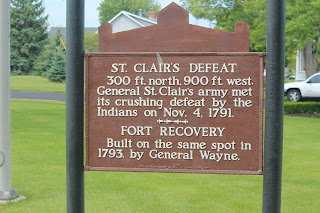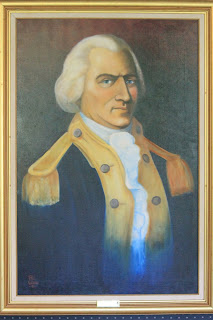Fort
Recovery, Ohio is a small town located near the head waters of the Wabash River.
The center of town boasts a towering obelisk as well as a partial reconstructed
fort. The town itself has only a few stop lights and a population of less than
1500 but it is a place of much historical significance. Unfortunately most
people have never heard of the town or its history.
If
you ask people to name the worst defeats ever handed down to an American
fighting force, you will most likely hear them mention Custer’s last stand at
the Battle of Little Bighorn or the 1812 invasion of Canada. You may even hear them
suggest that the Texan defeat at the Alamo is the worst. What you are probably
not going to hear mentioned is St Clair’s defeat at the Battle of the Wabash....but....
Why would you? Most history books and nearly all history classes skip right
over this significant battle in United States history.
The
Battle of the Wabash took place on a triangle stretch of land near the head
waters of the Wabash River in present day Fort Recovery, Ohio. The battle was
the largest confrontation between Native Americans and the United States Army
and it was also the largest defeat ever suffered by the United States Army. 900
of the roughly 1200 American soldiers met their fate at this battle. In total
25% of the entire American Army was decimated at the hands of the nearly 1500
native warriors. [1]
 Why
did the war happen?
Why
did the war happen?
After
the American Revolutionary War the newly formed American nation was deeply in
dept and needed to raise money to survive. Under the authority of the Treaty of
Paris the government planned to raise money by selling the newly acquired land
within the Northwest Territory. That idea sounds non hostile enough but there
was a major problem with that idea. The Northwest Territory was Indian country
and the Native American inhabitants who lived there were not part of the Treaty
of Paris and they had no desire to give their land to the American invaders. As
a result of settler expansion, tribes living northwest of the Ohio River
decided to band together in defense of their land and form what was called the
Western Indian Confederation. [2]
The
Confederation was led by Chief Little Turtle of the Miamis, Chief Blue Jacket
of the Shawnees and Chief Buckongahelas of the Delaware Indians. Blackhoof,
Tecumseh and his brother the Prophet were all members of the Confederation and
all were reported to have fought during the Battle of the Wabash.
 |
| General St. Clair |
Under
the orders of President George Washington General Arthur St. Clair had
undertook a campaign to rid the greater Ohio valley of all its native
inhabitants. Roughly 1200 soldiers and 250 civilians had set up camp near the
head waters of the Wabash River. On November 4th 1791 the first attack
took place. Led by Chief Little Turtle the first attack came so swiftly that
several of the American fighters fled in panic without even so much as grabbing
their guns. By the time the others readied themselves for battle Little Turtle’s
forces had already surrounding them. St Clair, with his cannons positioned in a
clearing on the high ground; ordered them to fire at the attacking natives. However,
unbeknown to him, Chief Blue Jacket had positioned his Shawnee marksmen to take
them out as soon as they were wheeled into position. Tecumseh and his band of
Indian scouts had been tracking and watching the movement of St. Clair’s men
for days. The Native attackers were very well prepared and they knew the lay of
the land.
The
battle raged for three long hours. In total 920 American soldiers and nearly
100 civilians were killed compared to the meager 21 Confederation warriors lost.
Severely wounded and in a final charge General St Clair managed to escape with
an estimated 200 soldiers and civilians but the battle was a near total annihilation
and a massive blow for the United States military.
 |
| St Clair Monument |
 |
| St. Clair statue |
The Aftermath
In the wake of the crushing defeat General St Clair resigned his commission and returned to the less dangerous role of Governor of the Ohio Territory. As a result of the Battle of the Wabash, congress passed two militia acts; one required that all able bodied men sign up for active duty in their state militias and the second granted the President the power to call upon those militias to fight on behalf of the United States.[3]
Under
his new found authority President Washington ordered that the army be enlarged
and within the year he had nearly doubled the previous size of the units under
the command of General “Mad Dog” Anthony Wayne. In 1793 General Wayne sent 8
infantry units along with artillery to the very sight of St. Clair’s defeat.
Wayne ordered the construction and fortification of Fort Recovery.
In
the coming months native skirmishes and raids were attempted but the Confederation
was now out manned and out gunned. The surrounding tribes would never again
find victory at the site and were forced to withdraw and flee the area.[4]
 | |
| Greenville Treaty Line Marker |
The
irony of The Battle of the Wabash is that it stands as Americas worst defeat at
the hands of the Native Americans but because of that defeat the battle also
stands as the call to arms that would lead to a national military and near
genocidal results for the Native inhabitants of the Northwest Territory.
[1] Winkler, John F. Wabash 1791: St Clair’s defeat.
Bloomsbury Publishing, 2011
[2] See Winkler and
Eid, Leroy V. "American Indian military leadership: St. Clair's 1791
defeat." The Journal of Military History 57, no. 1 (1993): 71.
[3] "1792 Militia Act establishes conscription under
federal law." 2009.
https://www.history.com/this-day-in-history/militia-act-establishes-conscription-under-federal-law.
[4] Hurt, R. Douglas. The Ohio Frontier:
Crucible of the Old Northwest, 1720-1830. Bloomington, IN: Indiana
University Press, 1996
[5] Pratt, G. Michael. "The Battle of Fallen Timbers: An Eyewitness Perspective." Northwest Ohio Quarterly 67 (1995): 4-34. and Sugden, John. Blue Jacket: Warrior of the Shawnees. Lincoln: University of Nebraska Press, 2000.
[5] Pratt, G. Michael. "The Battle of Fallen Timbers: An Eyewitness Perspective." Northwest Ohio Quarterly 67 (1995): 4-34. and Sugden, John. Blue Jacket: Warrior of the Shawnees. Lincoln: University of Nebraska Press, 2000.




No comments:
Post a Comment